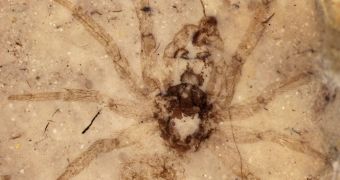Chinese experts have recently unearthed one of the most well-preserved fossils ever. It was left behind by a type of spider known as Eoplectreurys gertschi, of which only two other specimens were ever recovered. However, the newly discovered one is more than 120 million years older than its “peers,” as it dates back to the mid-Jurassic era, more than 165 million years ago. The creature therefore roamed the land when dinosaurs ruled supreme, and the place where it was captured upon dying managed to conserve all of its major features, Wired reports.
Researchers who have had the chance to see the amazing fossil say that the only thing you need to investigate the arthropod is a microscope. Experts say that the level of detail still preserved is amazing, and that this creature's remains will definitely provide them with more clues as to how the ecosystems of the time may have looked like. They emphasize that E. gertschi lived about 100 million years before dinosaurs went extinct, when many new species were still emerging, and natural selection and evolution were working around the clock, creating new animals.
“You go in with a microscope, and bingo! It’s fantastic,” University of Kansas paleontologist Paul Selden, who is also the lead author of a new paper detailing the findings, says. The work appears in the February 6 issue of the international scientific journal Naturwissenschaften. The expert also adds that the region where the spider fossil was discovered, the Daohugou site in northern China, was a lake all those years ago, located near a volcano. Over the years, as experts started taking an active interest in the area, a large selection of discoveries was made, including fossilized salamanders, small, primitive mammals, insects, and water crustaceans.
The finding also indicates that the family to which this species belonged, called Plectreuridae, was in fact a lot more widespread than initially estimated. Today, individuals belonging to it can only be found in selected areas of California, Arizona, Mexico and Cuba, but in the mid-Jurassic they roamed a huge stretch of land called the North China Block. “At some point something caused their range to contract to this part of southern North America,” Selden argues, saying that one of the main factors may have been a change in vegetation during an ice age. “But they were still happy in these arid areas of the Southwest,” he concludes.

 14 DAY TRIAL //
14 DAY TRIAL //